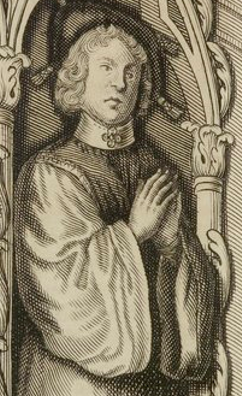
The County of Boulogne was a county within the Kingdom of France during the 9th to 15th centuries, centred on the city of Boulogne-sur-Mer. It was ruled by the counts of Flanders in the 10th century, but a separate House of Boulogne emerged during the 11th century. It was merged into the County of Artois by Philip II of France in 1212 and eventually annexed to the royal domain itself in 1477.

Louis de Bourbon was the third son of John I, Duke of Bourbon and Marie, Duchess of Auvergne. He was Count of Montpensier, Clermont-en-Auvergne and Sancerre and Dauphin of Auvergne and was a younger brother of Charles I of Bourbon. He founded the Bourbon-Montpensier branch of the House of Bourbon, which would eventually take over the Duchy in 1505.
Jean de Poitiers, Lord of Saint Vallier was a French nobleman best known as the father of Diane de Poitiers, mistress of King Henry II of France.

The House of La Trémoïlle(Maison de La Trémoille in French) was a French noble family from Poitou whose name comes from the village La Trimouille in the department of Vienne. This family has been known since the middle of the 11th century, and since the 14th century its members have been conspicuous in French history as nobles, military leaders and crusaders, and influential as political leaders, diplomats, Huguenots and courtiers. The male line of the family died out in 1933, while female line heirs of the last duke have kept the La Trémoïlle surname alive in Belgium.

Georges de la Trémoille was Count of Guînes from 1398 to 1446 and Grand Chamberlain of France to King Charles VII of France. He sought reconciliation between Philip, Duke of Burgundy and Charles VII during their estrangement in the latter part of the Hundred Years' War. De la Trémoille was a political opponent of Arthur de Richemont within the French court. Most historians take a poor view of his career, assessing that he placed personal advancement before the public interest, though the traditional historical interpretation of the Grand Chamberlain as Jeanne d'Arc's opponent has been revised.

The House of La Tour d'Auvergne was an important French noble dynasty. Its senior branch, extinct in 1501, held two of the last large fiefs acquired by the French crown, the counties of Auvergne and Boulogne, for about half a century. Its cadet branch, extinct in 1802, ruled the duchy of Bouillon in the Southern Netherlands from 1594, and held the dukedoms of Albret and Château-Thierry in the peerage of France since 1660. The name was also borne by Philippe d'Auvergne, an alleged collateral of the original Counts of Auvergne, and was adopted by the famous soldier Théophile Corret de la Tour d'Auvergne, who descended from an illegitimate line of the family.

John III of Auvergne, Count of Auvergne, Count of Boulogne, Count de Lauraguais, was the son of Bertrand VI, Count of Auvergne and Louise de La Trémoille, Dame de Boussac, the daughter of Georges de la Trémoille. He was the last in the male line of Counts of Auvergne from the La Tour d'Auvergne family.

Joan II, Countess of Auvergne and Boulogne, also known as Jeanne de Boulogne and Joan, Duchess of Berry, was sovereign Countess of Auvergne and Boulogne from 1394 until 1424. She was the daughter of John II, Count of Auvergne, and second wife of John, Duke of Berry. She is arguably most famous for saving the life of her nephew, King Charles VI of France, during the disastrous Bal des Ardents.

The House of Amboise was one of the oldest families of the French nobility whose followed filiation dated back to the early twelfth century. It took its name from the town of Amboise in Touraine.
Marie I of Auvergne was suo jureCountess of Auvergne and Countess of Boulogne from 1424 to her death in 1437, having inherited the titles from her cousin Joan II, Countess of Auvergne. She was also styled Dame of Montgascon. She was the wife of Bertrand IV de La Tour, and the mother of Bertrand V de La Tour who succeeded her as Count of Auvergne and Boulogne.

Count of Boulogne was a historical title in the Kingdom of France. The city of Boulogne-sur-Mer became the centre of the county of Boulogne during the ninth century. Little is known of the early counts, but the first holder of the title is recorded in the 11th century.

William XI or William XII was the Count of Auvergne and Boulogne from 1277 until his death no later than 1279.

John II was the Count of Auvergne and Boulogne from 1386 until his death in 1404.
Gabrielle de La Tour d'Auvergne, Countess of Montpensier, was born around 1420 and died in 1474. She was the second wife of Louis I, Count of Montpensier, whom she married in 1442. Gabrielle de La Tour d'Auvergne is best known for the extensive library recorded in her posthumous inventory.

Robert VII of Auvergne was count of Auvergne and Boulogne from 1317 until his death.

Robert V of Auvergne was count of Auvergne from 1247 and Boulogne from 1265 until his death.

Robert VI of Auvergne was count of Auvergne and Boulogne from 1277 until his death.
Bertrand V was lord of La Tour from 1423 and count of Auvergne and Boulogne from 1437 until his death.













